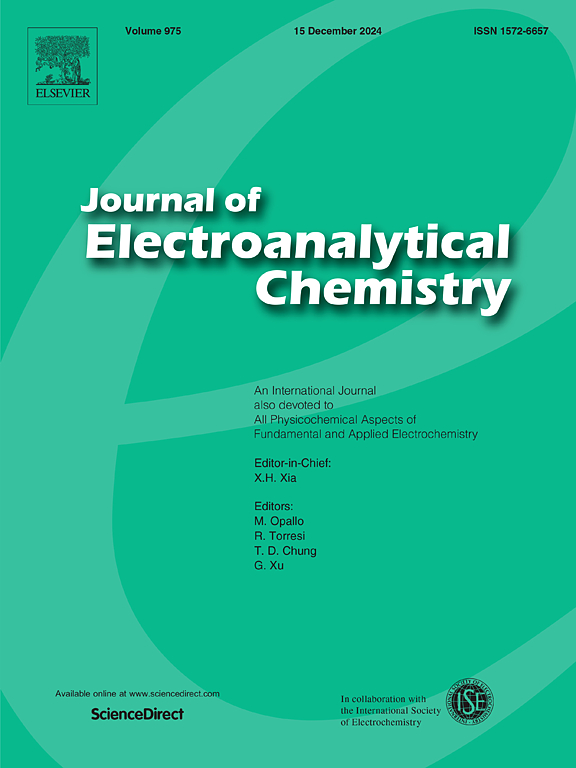氧化镍电致变色复合膜掺钛种子层的微观结构与能带结构耦合调控
IF 4.1
3区 化学
Q1 CHEMISTRY, ANALYTICAL
引用次数: 0
摘要
结构调整和掺杂改性是提高阳极氧化镍电致变色薄膜电化学和电致变色性能的重要手段。如何提高循环稳定性对于氧化镍电致变色薄膜的应用至关重要。在这项工作中,我们通过溶胶-凝胶旋涂法制备了具有不同精确化学计量比的掺钛种子层。随后,通过简单的水热工艺,在这些种子层上成功制备了氧化镍复合薄膜。值得注意的是,在所有样品中,A 1/8 样品具有优异的电致变色性能,包括较大的光学调制幅度(550 纳米波长下为 69.61%)、较快的响应时间(5.0 和 6.2 秒)、较高的着色效率(33.87 cm2/C)和出色的循环稳定性(3300 次循环)。种子层在防止电解质与电极直接接触、诱导自组装结构的生长以及增强薄膜与电极之间的附着力方面起着至关重要的作用。掺钛种子层可以调节复合薄膜的微观结构和带状结构,从而影响薄膜的电致变色特性。在这项工作中,我们证明了通过结构和掺杂的双重调节,氧化镍复合薄膜的循环稳定性得到了改善。A 1/8 样品表现出优异的循环稳定性,这归功于多通道纳米结构的耦合效应,并降低了与 FTO 的界面势垒。本文章由计算机程序翻译,如有差异,请以英文原文为准。
The microstructure and energy-band structure coupling regulation of Ti-doped seed layer for the NiO electrochromic composite films
Structure regulation and doping modification are important means to enhance the electrochemical and electrochromic performance of anode NiO electrochromic films. How to improve cycle stability is crucial for the application of NiO electrochromic films. In this work, we prepared Ti-doped seed layers with varying precise chemical stoichiometry ratios through the sol–gel spin coating method. Subsequently, NiO composite films were successfully fabricated on these seed layers through a simple hydrothermal process. Notably, among all the samples, the A 1/8 sample exhibits superior electrochromic performance, including a large optical modulation amplitude (69.61 % at 550 nm), faster response time (5.0 and 6.2 s), high coloring efficiency (33.87 cm2/C), and excellent cycle stability (3300 cycles). The seed layer plays a crucial role in preventing direct contact between the electrolyte and the electrode, inducing the growth of self-assembled structures, and enhancing adhesion between the film and the electrode. The Ti-doped seed layer can regulate the composite film microstructure and band structure, impacting the film electrochromic properties. In this work, we demonstrate that the cycle stability of the NiO composite films is improved through dual regulation of structure and doping. The A 1/8 sample exhibits superior cycle stability, attributed to the coupling effect of multi-channel nanostructure, and reduces interface barrier with FTO.
求助全文
通过发布文献求助,成功后即可免费获取论文全文。
去求助
来源期刊
CiteScore
7.80
自引率
6.70%
发文量
912
审稿时长
2.4 months
期刊介绍:
The Journal of Electroanalytical Chemistry is the foremost international journal devoted to the interdisciplinary subject of electrochemistry in all its aspects, theoretical as well as applied.
Electrochemistry is a wide ranging area that is in a state of continuous evolution. Rather than compiling a long list of topics covered by the Journal, the editors would like to draw particular attention to the key issues of novelty, topicality and quality. Papers should present new and interesting electrochemical science in a way that is accessible to the reader. The presentation and discussion should be at a level that is consistent with the international status of the Journal. Reports describing the application of well-established techniques to problems that are essentially technical will not be accepted. Similarly, papers that report observations but fail to provide adequate interpretation will be rejected by the Editors. Papers dealing with technical electrochemistry should be submitted to other specialist journals unless the authors can show that their work provides substantially new insights into electrochemical processes.

 求助内容:
求助内容: 应助结果提醒方式:
应助结果提醒方式:


